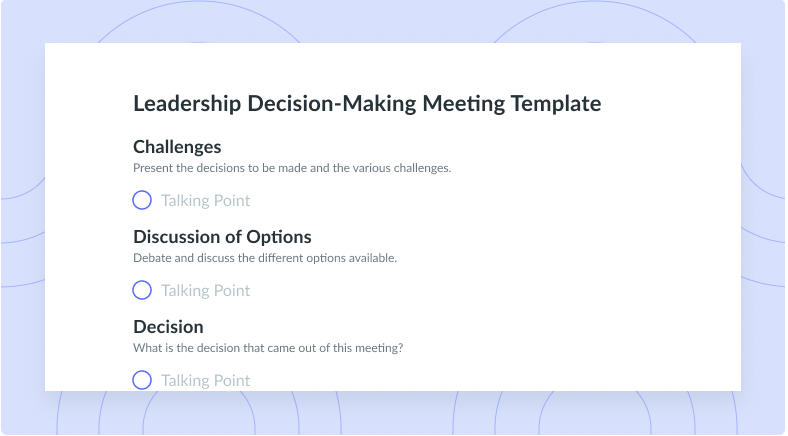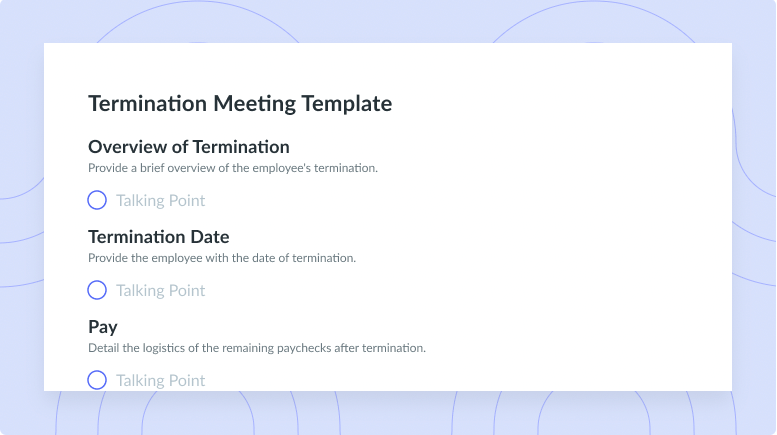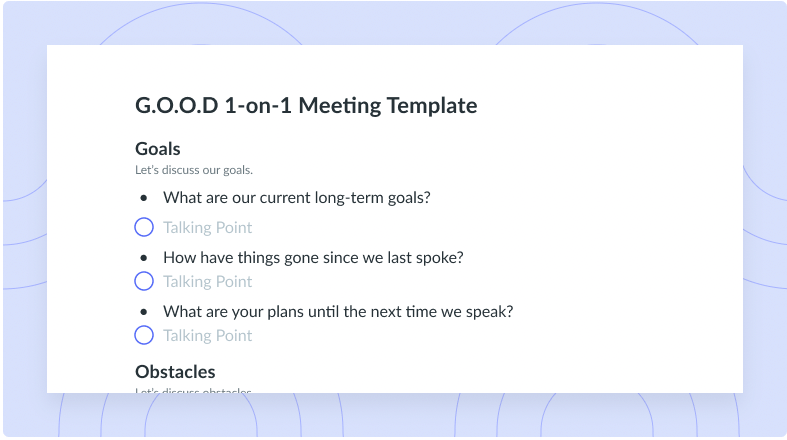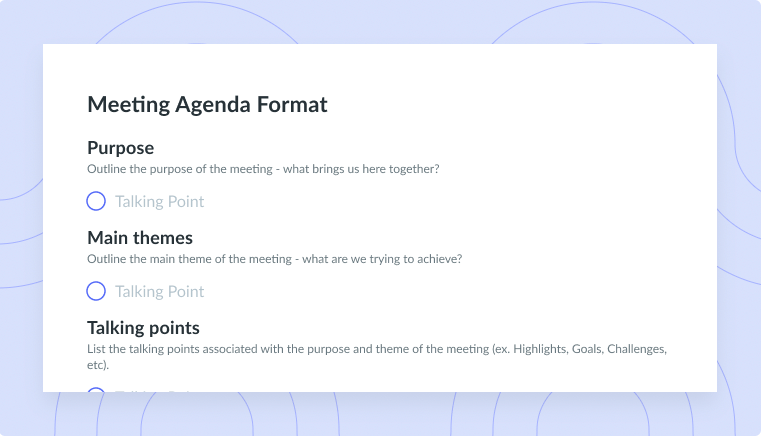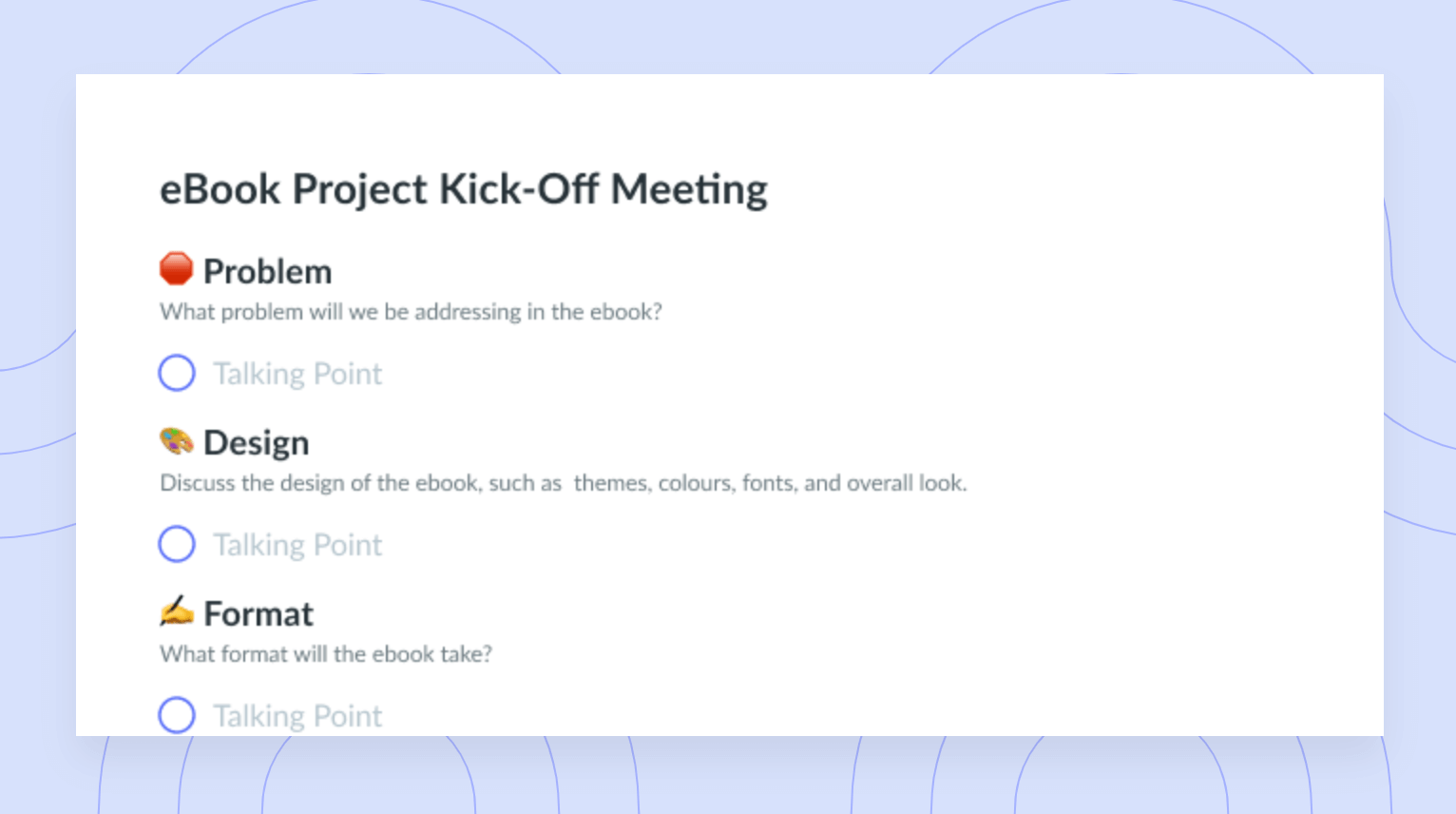How to Write a Meeting Summary (+Free Template)
Best practices for crafting the perfect meeting summary backed by tips, tricks, and a meeting summary template.
The importance of a well-written meeting summary cannot be overstated. Knowing how to summarize meetings effectively will ensure you’ve kept a clear record of key takeaways including the date, time, and location of the meeting, a list of attendees, agenda items, discussion points, decisions made, action items, next steps, follow-ups, closing remarks, and attachments. In this article, we’ll outline how to prepare and simplify the process of writing a meeting summary so you can keep a detailed record of each meeting while fostering alignment amongst your teammates.
- What is a meeting summary?
- Meeting summary vs. meeting minutes
- How to prepare and simplify the process of writing a meeting summary
- How to write a meeting summary
- How to use Fellow to automate meeting summaries
- Meeting summary template
What is a meeting summary?
A meeting summary (or meeting recap) is a document or transcript that accounts for key talking points, decisions, and action items that were discussed during the meeting. The goal of a meeting summary is to gather all pertinent information from the meeting and make it available after the meeting to meeting attendees as well as those who couldn’t attend. A comprehensive meeting summary or meeting recap will include the date, time, and location of the meeting, a list of attendees, agenda items, discussion points, decisions made, action items, next steps, follow-ups, closing remarks, and attachments.
Meeting summary vs. meeting minutes
Meeting minutes are often formal, structured, and more detailed when compared to a meeting summary. While a summary does outline occurrences from the meeting, it only depicts a high-level overview versus a word-for-word transcription. When choosing between a meeting summary and meeting minutes, your decision will largely depend on your intended objective, the audience, and the level of detail required.

Keep an accurate record of discussions and decisions with AI meeting summaries
Fellow’s AI meeting summaries provide all the key takeaways from your meetings in minutes so you can revisit discussions and align around next steps.
How to prepare and simplify the process of writing a meeting summary
1Take collaborative notes
Taking collaborative notes is a great way to engage your teammates while simultaneously ensuring that no detail is unaccounted for. Providing everybody with the opportunity to collaborate on the meeting notes will ensure that every topic is accounted for and covered from each perspective. To simplify the process of crafting a meeting summary, consider hosting your meeting with a collaborative meeting agenda. Fellow’s easy-to-use agenda builder ensures that your meetings start with clarity and that everyone feels inspired to contribute. With Fellow, you can have one source of truth for every meeting, boost transparency and accountability, and never forget what was discussed. You can take your productivity one step further with Fellow’s browser extensions, unlocking the ability to access your meeting notes right inside of Google Meet calls and your Google Calendar to supercharge team meetings and one-on-ones without leaving the tools you’re already using.
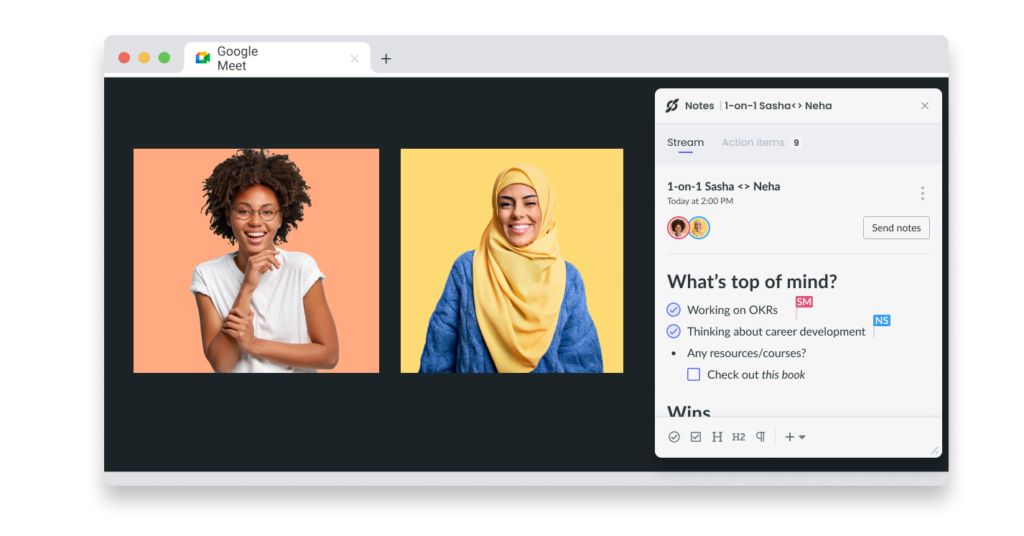
2Assign action items
Action items are a crucial component of a well-written meeting summary, which is why it’s important to assign action items during the meeting. Assigning action items at the end of your meeting also ensures that information that was discussed is acted upon by the appropriate parties, eliminating the risk of missed deadlines and poor accountability.
If you struggle to foster accountability within your team after assigning action items, it may be time to leverage a meeting management tool like Fellow. Fellow makes it possible to keep the momentum going after each meeting by providing you with one easy-to-use tool you can leverage to assign, visualize, and prioritize all meeting action items in one place.

3Record the meeting
Keeping track of everything that was discussed during a meeting can be incredibly difficult, which is why note-taking and recordings are so important. Recording your meeting will provide you with a base that you can pull from when it comes time to craft the perfect meeting summary, ensuring you don’t forget any details, talking points, decisions, or action items. Not only will recording your meeting make it easier for you to craft your summary, but it will also ensure that everyone has access to the meeting content.
Did you know that Fellow has artificial intelligence (AI)–powered recording, transcription, and summarization capabilities that can help you and your team enhance your meeting experience? Using the meeting recording feature is as simple as adding the Fellow Meeting Assistant to your Google Meet, Microsoft Teams, or Zoom calls, pressing record, and running your meeting as normal. The Fellow Meeting Assistant will start recording and transcribing right away. After the meeting has ended, you can click on the meeting summary to view the entire transcript of the meeting as well as the recording.
4Gather relevant materials discussed
A meeting summary is an overview of everything that was covered during the meeting, so it’s important to gather all relevant materials that were discussed. In addition to talking points, decisions that were made, and action items, it’s also important to gather all relevant materials. Taking the time to gather all relevant assets will ensure you don’t forget anything when it comes time to prepare the meeting summary. This may include a white paper that was presented during the meeting, a pitch deck that was used to teach a lesson, or a video that was used to speak to a new product. Rounding up relevant materials and assets will ensure no crucial elements are left out when it comes time to send out the meeting summary.
How to write a meeting summary
- Thank attendees for their input and participation
- Begin by summarizing the most important topics discussed
- Attach relevant materials
- Include meeting action items
- Clearly outline decisions that were made
- Include the next meeting’s date and time
- Share the meeting summary ASAP
1Thank attendees for their input and participation
It’s important to thank attendees for their input and participation both during the meeting and in the post-meeting follow-up. If you don’t get a chance to thank your peers during the meeting, this can be a great transition into the meeting summary. This simple act that takes no effort on your end will go a long way in reminding your colleagues that they are appreciated and respected.
2Begin by summarizing the most important topics discussed
A meeting summary should serve as a concise representation of what was discussed during the meeting. This means taking note of important details and decisions and forgoing those that don’t serve a purpose. Only including the most important topics in the meeting summary will ensure crucial details don’t get lost in the noise.
3Attach relevant materials
A meeting summary is a great resource that can be used to centralize all important information from the meeting. This serves as an excellent opportunity to include any relevant materials that were referenced—like a slide deck from the meeting or a document that was reviewed—ensuring those who were in attendance as well as those who weren’t able to attend have access to all pertinent information.
4Include meeting action items
When crafting your meeting summary, it’s included to include any action items that were discussed during this meeting. In this section, be sure to include each action item, who is responsible for each action item, and when the action item is due.
5Clearly outline decisions that were made
It can be difficult to remember every decision that was made during a meeting, which is one reason meeting summaries are so important. Clearly outlining and documenting all decisions that were made during the meeting in the meeting summary will ensure everyone is informed and on the same page. It also creates a paper trail so there aren’t any miscommunications regarding decisions that were made.
6Include the next meeting’s date and time
If your meeting is recurring, it’s important to ensure that you’ve noted the date and time of the upcoming meeting in the meeting summary. Doing so will ensure guests have ample notice to schedule the meeting into their calendars, resulting in increased engagement and attendance. This also means there won’t be misunderstandings or conflicts that get in the way of future participation.
7Share the meeting summary ASAP
It’s important to send the meeting summary as soon as the meeting ends to ensure everyone has access to all pertinent information immediately. Failing to send the meeting summary right away may result in important information being missed, forgotten, or overlooked. Sending out the summary right away will ensure all information is accessible and top of mind.
How to use Fellow to automate meeting summaries
Fellow has a brand new feature that makes it easier than ever to capture comprehensive meeting summaries. Fellow’s new AI meeting copilot is quick and easy to enable. Simply switch the feature on and your AI meeting assistant will join your meeting. This tool will run in the background as you and your teammates meet, and at the end of the meeting you will receive a comprehensive meeting summary, so you never have to worry about crafting a meeting summary from scratch again. You can easily access your meeting notes, talking points, action items, and meeting summary in one easy-to-use tool that streamlines your entire meeting workflow!
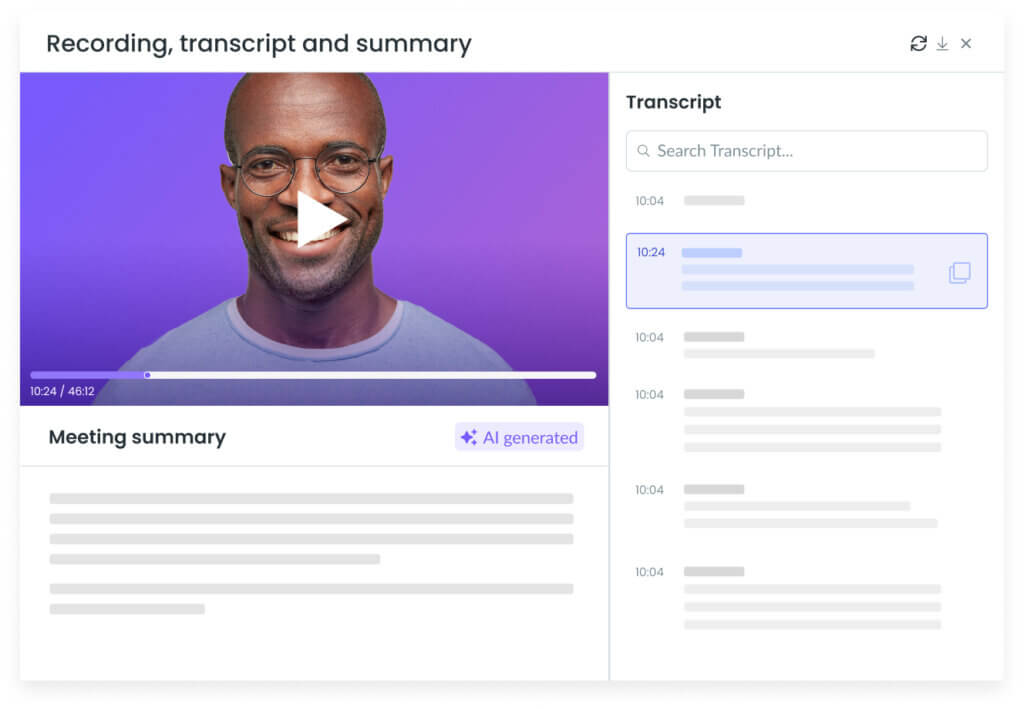
Meeting summary template
Email Subject: Meeting Summary [Meeting name and date]
Hello, [Team name]
Thank you so much for your participation in today’s meeting, please find a summary in the paragraphs below.
- [First discussion topics and details]
- [Second discussion topic and details]
- [Third discussion topic and details]
Please see action items below:
- [First action item, assignee, date due]
- [Second action item, assignee, date due]
- [Third action item, assignee, date due]
[Date of next meeting]
Thank you, [Your name]
Ready to hack your meeting game?
Learning how to properly record key takeaways from each meeting is a major productivity hack. Taking these tips and the template into consideration will ensure you’re equipped with the knowledge and resources necessary to craft and circulate a comprehensive meeting summary.

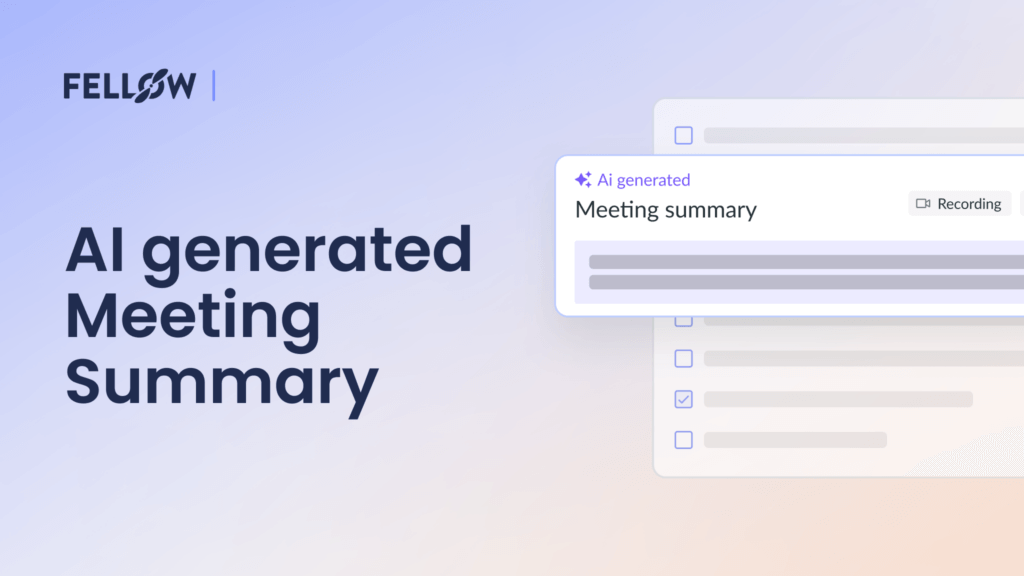
![How to Write a Meeting Recap [With Templates]](https://fellow.app/wp-content/uploads/2021/02/Meeting-Recaps.jpg)
![How to Write a Thank You Email After a Meeting [+Template]](https://fellow.app/wp-content/uploads/2023/12/thank-you-for-the-meeting-email-2.jpg)






![Tips for Writing an Effective Executive Summary [+ Example]](https://fellow.app/wp-content/uploads/2022/05/Writing-an-Effective-Executive-Summary.jpg)



